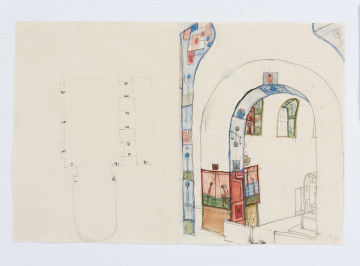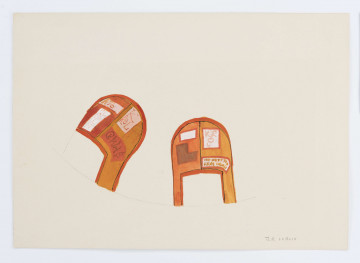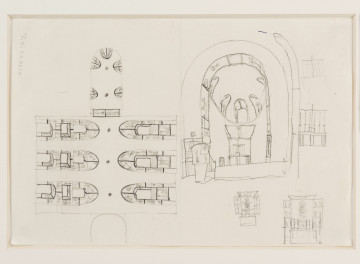
Unimplemented design for the polychrome for the Academic Church of the Catholic University of Lublin. View of the church, the decoration of the presbytery and the rainbow wall
1962
National Museum in Lublin
Part of the collection: Religious scenes
An important part of Jerzy Nowosielski's work are the realisations of polychromes in Orthodox, Greek and Roman Catholic churches, which are an expression of the coexistence and interpenetration of Eastern and Western cultures, icon painting and the art of abstraction. In the early 1960s, the artist received a proposal to create a polychrome in the academic church of the Catholic University of Lublin. Similarly, to other monumental painting projects, Nowosielski treated them as a kind of ecumenical sermon, the aim of which was to show the unity of worship. According to the artist's letter to Andrzej Grzegorczyk, for Lublin he created "a completely uncompromising project" with a clear iconographic message, the realization of which was particularly important to him. Unfortunately, Nowosielski's vision was rejected, and the artist's idea is represented only by a set of design sketches, nine of which were bought by the Lublin Museum thanks to a grant from the Ministry of Culture and National Heritage. The polychrome design, in accordance with the traditional programme of Byzantine churches, assumed a zonal composition of framed scenes filling the interior. Similarly to the projects of painting decorations of other temples, the artist prepared several versions of the polychrome for the Holy Cross Church, differing in the iconographic programme and colours.
Nowosielski created not only a comprehensive concept of the painting decoration, but also of the temple equipment, including the design of the chancel decoration with the form of the main altar, worked out in several quite detailed variants. It assumes the presence of an elaborate altarpiece with a rectangular body and a pair of closed wings with different finials. The central part of the altarpiece was probably designed to depict Christ Pantocrator (Omnipotent) in the type of Salvator Mundi (Saviour of the World) with a royal apple or a globe in his hand. The too general nature of the sketch makes it impossible to reconstruct the iconographic programme of the predella and the scenes in the individual quarters of the wings. In each of the variants the simple altar mensa was equipped with a cross and a pair of candlesticks set on the sides.
Anna Hałata
Author / creator
Dimensions
cały obiekt: height: 30 cm, width: 20 cm
Object type
drawing
Technique
drawing technique
Material
paper, pencil
Creation time / dating
Creation / finding place
Owner
The National Museum in Lublin
Identification number
Location / status

1962
National Museum in Lublin

1962
National Museum in Lublin

1962
National Museum in Lublin
DISCOVER this TOPIC
Museum of King Jan III's Palace at Wilanów
DISCOVER this PATH
Educational path